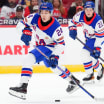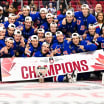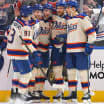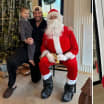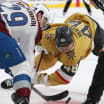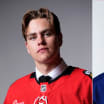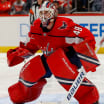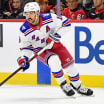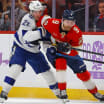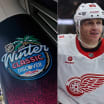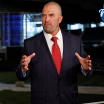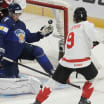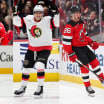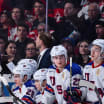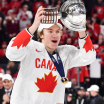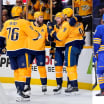Legendary hockey reporter Stan Fischer writes a weekly scrapbook for NHL.com. Fischler, known as "The Hockey Maven," shares his humor and insight with readers each Wednesday.
With Thanksgiving being celebrated Thursday in the United States, Fischler -- after more than a half-century covering the NHL -- offers 10 hockey-related reasons he is thankful.
Fischler thankful for upcoming induction into U.S. Hockey Hall of Fame
Veteran journalist lists what he appreciates ahead of Thanksgiving in United States
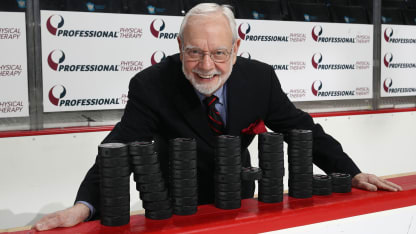
By
Stan Fischler
Special to NHL.com
1. THE ORIGINAL SIX: I began watching the New York Rangers in 1942. There were only five other NHL teams -- the Montreal Canadiens, Toronto Maple Leafs, Chicago Black Hawks, Boston Bruins and Detroit Red Wings -- but we appreciated what we had. The era was so different but so much fun in its own ancient way. No goalie wore a mask and only one player, Bruins defenseman Jack Crawford, wore a helmet, and that was only because he was embarrassed to be bald. All sticks were made of wood with perfectly straight blades. The rivalries were intense because the teams played each other so often. I'm so thankful to have been around to see the Hall of Fame players of that generation such as Gordie Howe, Maurice Richard, Milt Schmidt, Doug Bentley and Charlie Rayner in their Original Six primes.
2. UNCLE SAM'S WAR HEROES: Before serving overseas, a group of United States Coast Guardsmen formed a hockey team in Baltimore during World War II. Stationed at Curtis Bay Yard, the Star-Spangled skaters included such future Hockey Hall of Famers as goalie Frank Brimsek (Bruins) and defenseman Art Coulter (Rangers). The Cutters won the Eastern Amateur Hockey League title in 1942-43 and 1943-44. A rough and tumble outfit, "Hooligan's Navy" would appear at Madison Square Garden on Sundays playing against the Rovers, a Rangers farm team. Like everyone else, I hated the war but I was thankful that out of it came one of the most unusual hockey teams ever to play in America. And how could it not be when the sailors brought a 30-piece marching band to every game? When the Coast Guard scored, the band would play "Semper Paratus," (Always Ready), the Coast Guard's official theme. It made 11-year-old me very proud, excited and thankful.
3. NEW YORK'S UNIQUE HOCKEY ANNOUNCERS: My introduction to Rangers radio broadcasts came in 1945. Bert Lee and Ward Wilson handled the play by play and color commentary, respectively. Lee was known for his unique expressions. If the game was a sellout, he'd say "They're standing on every shelf." When a puck hit the post he'd yell, "It missed by inches only." And if the Rangers were losing, Lee would turn to Ward and say, "Time enough for one goal, time enough for 20!" Since hockey news was relatively scarce in those days, I was very thankful to have had Wilson and Lee delivering the action and stories in such a fun way. One of their gimmicks was called, "The Eichler (beer) Automatic Goal Judge." When the Rangers scored, Lee would blow three horns that sounded like the Cole Porter song, "You're the Top." It so happened that Eichler's theme was "It's the Top." The combination was a rare winner … if you liked the Rangers!
4. EARLY AMERICAN HOCKEY STARS: United States-born hockey players were rare during the 1940s, but those who played in the NHL were outstanding. One was Rangers defenseman Bill Moe, who had a knack of hip-checking foes upside down. He did it to Toronto's Gaye Stewart in 1946-47 and the hit was captured in a prize-winning photo. Another was Black Hawks defenseman Johnny Mariucci, one of the toughest players in NHL history. Then there was Chicago goalie Sam LoPresti. He set a League record on March 4, 1941, when he made 83 saves in a 3-2 loss to the Bruins. During World War II, LoPresti served in the U.S. Navy Armed Guard section on cargo ships. He was honored for a heroic rescue of 19 mates after their ship was torpedoed in the Atlantic Ocean. As an American hockey fan, I was so awed and thankful that my country could develop hockey stars who also served Uncle Sam.
5. A MEMORABLE NIGHT: In the fall of 1947, the Rangers honored their legendary leader, "The Silver Fox," with Lester Patrick Night at old Madison Square Garden. I sat in the end balcony for the ceremony which preceded a game against the Maple Leafs. Among my personal highlights was seeing the Rangers' 1928 and 1933 Stanley Cup-winning line of Bill and Bun Cook alongside their centert Frank Boucher. The Rangers legends showed up at center ice along with the honoree, their manager-coach, Lester Patrick. Exactly 60 years later I was honored to be awarded the Lester Patrick Trophy for contributions to ice hockey in the United States. I'm forever thankful for having been around for each event.
6. MY FIRST PLAYOFF GAME: Because the Rangers missed the Stanley Cup Playoffs for five straight seasons in the 1940s, New Yorkers like myself didn't know how exciting a postseason game could be. When the Rangers finally qualified in 1948, being at an actual Stanley Cup Playoff game felt as if I was attending a royal wedding. It was a terrific happening for me as well as for my younger cousin, Ira Sheier, who was equally as thrilled. While we were dismayed that the Red Wings defeated the Rangers, we remained grateful and thankful to finally be at a playoff contest in Manhattan.
7. GETTING PAID TO WORK IN HOCKEY: Just out of Brooklyn College in 1954, I was hired by Rangers publicist Herb Goren to be his assistant. Not only was I gifted with a dream job but I also was getting paid, $50 a week, for being in hockey heaven. My boss was the genial, erudite manager Frank Boucher and our coach was Muzz Patrick. I never will stop being thankful to Goren for hiring me. Also, to New York Journal-American hockey writer Stan Saplin for being my journalistic mentor when I eventually became the Rangers beat writer for the same newspaper.
8. MY HOCKEY WIFE: If a fellow spent a lifetime being crazy about hockey, it sure would help to marry a woman who shared that passion. Shirley Walton Fischler was an amazing teammate, writer, researcher and mother to Ben and Simon. No question, without Shirley's support, guidance and wisdom, I never would have been able to write so many hockey books. Among her many other virtues, Shirley was the brains behind our complicated and innovative Macmillan Hockey Encyclopedia. In addition, she wrote hockey books on her own and added gloss to the Fischler name by spearheading a move to allow women in the heretofore men-only press box at Madison Square Garden. How thankful I am to have had Shirley as my partner both in hockey and life.
9. STAN'S STANLEY CUP TITLES: As both a print and electronic reporter, I was fortunate to cover the New York Islanders dynasty of four straight Stanley Cup championships from 1980-83, the Rangers' 1994 Cup victory and all three New Jersey Devils titles. Working TV first for SportsChannel (thank you Marty Glickman and Chuck Dolan) and then MSG Networks was like living in a dream world. Thanks to Lou Lamoriello, Bill Torrey, Al Arbour, Herb Brooks, Jacques Lemaire, Tom Renney, Ben Olan, Ken McKenzie and Frank Brown, among the many others who have boosted my career. P.S.: And that goes for the legion of interns without whom I never could have succeeded. Thankfully, many have gone on to significant jobs in the hockey world.
10. HALL OF FAMER: Last June I received a phone call revealing that I would be inducted into the U.S. Hockey Hall of Fame. I never learned exactly who was behind my nomination although there are the usual suspects. Those who have backed me over the years include pals such as NHL Commissioner Gary Bettman and Deputy Commissioner Bill Daly as well as Islanders co-owner Jon Ledecky and Lamoriello, their general manager. On Dec. 9 I expect to be in Denver to receive my formal induction along with co-inductees Peter McNab and Paul Holmgren. Guess how thankful I am for that!
